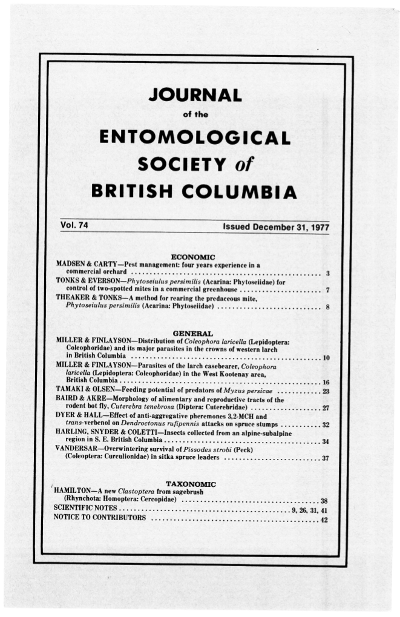Pest management: Four years experience in a commercial apple orchard
Abstract
Pest management in a 12-ha apple orchard from 1973 to 1976 resulted in a 50 percent reduction in the number of sprays that are normally applied to control insects and mites. Codling moth, <i>Laspeyresia pomonella</i> (L.), populations were monitored by sex pheromone traps and populations of other insects and mites were assessed by specific sampling techniques. Leafrollers were the most difficult pests to control and fruit injury was 1.5 to 2.0 percent in 3 of the 4 years. Mites were held below treatment levels by the predator, <i>Typhlodromus occidentalis</i> Nesbitt, except for the apple rust mite, <i>Aculus schlechtendali</i> (Nalepa) which required chemical control.References
Downing, R.S. and J.C. Arrand. 1976. Integrated control of orchard mites on apple in British Columbia. Can. Ent. 108:77-81.
Haley, Sue. 1976. Apple pest management in the North Okanagan Valley, British Columbia: A feasibility study. M.A. Thesis. Simon Fraser University. Burnaby. B.C. pp. 1-48.
Madsen. H.F., F.E. Peters, and J.M. Vakenti. 1975. Pest management: Experience in six British Columbia apple orchards. Can. Ent. 107:873-877.
Madsen. H.F. and F.E. Peters. 1976. Pest management: Monitoring populations of Archips argyrospilus and Archips rosanus (Lepidoptera: Tortricidae) with sex pheromone traps. Ibid. 108:1281-1284.
Madsen, H.F. and B.E. Carty. 1977. Fruittree leafroller (Lepidoptera: Tortricidae): Control of a population tolerant to diazinon. J. Econ. Ent. (in press).
Vakenti, J.M. and H.F. Madsen. 1976. Codling moth (Lepidoptera: Olethreutidae): Monitoring populations in apple orchards with sex pheromone traps. Can. Ent. 108:433-438.
Downloads
Published
Issue
Section
License
Authors who publish with the Journal of the Entomological Society of British Columbia agree to the following terms:
-Authors retain copyright and grant the journal right of first publication with the work simultaneously licensed under a Creative Commons Attribution License that allows others to share the work with an acknowledgement of the work's authorship and initial publication in this journal.
-Authors are able to enter into separate, additional contractual arrangements for the non-exclusive distribution of the journal's published version of the work (e.g., post it to an institutional repository or publish it in a book), with an acknowledgement of its initial publication in this journal.
-Authors are permitted and encouraged to post their work online (e.g., in institutional repositories or on their website) prior to and during the submission process, as it can lead to productive exchanges, as well as earlier and greater citation of published work (See The Effect of Open Access).


